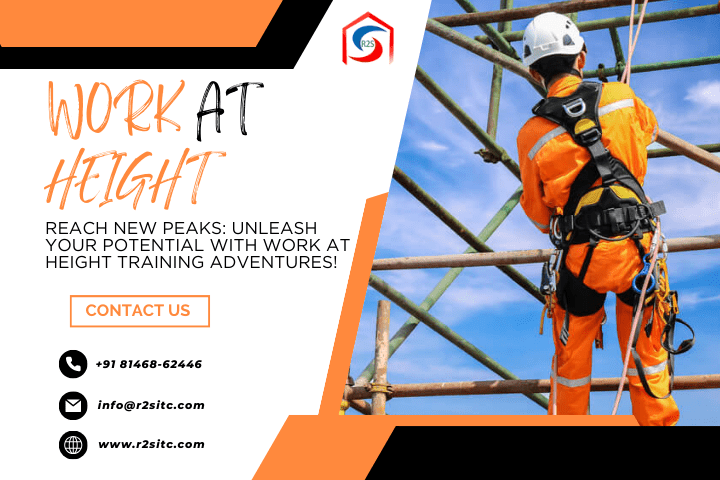Introduction:
In the fast-paced world of construction and industry, working at heights is a requirement for many employment tasks. When building tall buildings or maintaining intricate industrial machinery, workers frequently find themselves in high altitudes. Because safety is of the utmost importance, businesses use specific training programs to make sure that their employees are prepared for the difficulties that come with working at heights. R2SITC offers one such training program that’s causing waves in the market. We’ll examine the importance of work at height training in this blog post, as well as how R2SITC is raising the bar for safety.
Understanding the Importance of Work at Height Training:
Many industries, including telecommunications, energy, and construction and maintenance, depend heavily on workers who are able to reach great heights. These jobs are essential, but they also carry inherent dangers that, if not adequately managed, can result in mishaps and injuries. At this point, working at a height becomes quite important. Let’s examine the main justifications for why both firms and employees should make this type of training investment.
1. Risk Reduction:
Reducing the dangers related to work at elevation is the main objective of work at height training. For the safety of employees, it is essential to comprehend potential dangers and learn how to manage and reduce them. Topics including danger identification, risk assessment, and the use of efficient control mechanisms are frequently included in training programs.
2. Legal Compliance:
Strict laws and regulations pertaining to the safety of working at heights are in place in many nations. Employers are required by law to make sure that their staff members are properly trained to carry out jobs at an elevation. There may be fines, legal repercussions, and reputational harm to the organization if certain regulations are broken. Employers and employees are guaranteed to be aware of and in compliance with pertinent safety rules through work at height training.
3. Increased Awareness:
Work at height training helps employees become more conscious of the risks they can face when carrying out jobs at an elevated height. This raised consciousness encourages a safety-conscious work environment. Accidents are less likely to occur when workers become more aware of their surroundings, potential hazards, and the significance of following safety procedures.
4. Proper Use of Safety Equipment:
When working at heights, safety gear including lanyards, harnesses, and fall arrest systems are frequently needed. Workers that have received the necessary training will be able to operate, examine, and maintain this equipment correctly. Not only does wearing and using safety gear increase the efficacy of these measures, but it also drastically lowers the likelihood of accidents.
5. Emergency Preparedness:
Despite all precautions, accidents can still occur. Emergency response protocols are included in work at height training, which teaches employees how to act swiftly and efficiently in the event of an emergency. To guarantee that help can be given quickly, this covers rescue methods, first aid, and communication protocols.
6. Reduction in Accidents and Injuries:
Investing in work at height training directly affects the decrease in accidents and injuries that occur at work. An atmosphere at work is safer when workers are well-trained because they can recognize and handle possible threats more effectively. This reduces downtime and related expenses brought on by accidents in addition to safeguarding worker safety.
7. Increased Productivity:
A more productive workforce is one that has confidence in their capacity to work securely at heights. Workers who have received the appropriate training are probably going to work harder and more productively as they understand how important it is to keep them safe. This helps ensure that jobs are successfully completed at elevation and boosts overall productivity.
R2SITC: Redefining Work at Height Training
Leading provider of specialized training solutions for working at heights is R2SITC, or Road 2 Safety International Training Consultancy. Their curriculum goes beyond the fundamentals by using a comprehensive approach that includes real-world simulations, practical skills, and academic understanding. Here are a few distinctive features of R2SITC:
1. Innovative Training Modules: The training materials offered by R2SITC are made to be both interesting and useful. Through immersive virtual reality experiences and practical exercises, users are presented with a range of settings that closely resemble real-world work environments.
2. Importance on Equipment Familiarization: Using safety equipment correctly is essential when working at a height. Training participants on how to properly use safety harnesses, lanyards, and other necessary equipment is a top priority for R2SITC.
3. Risk Assessment Expertise: A crucial part of R2SITC’s training is comprehending and evaluating the dangers related to operating at heights. Participants gain knowledge on how to recognize possible risks, assess risk severity, and put efficient control mechanisms in place.
4. Emergency Response Training: In the case of an occurrence, prompt and efficient action is essential. R2SITC makes sure that participants are knowledgeable about emergency protocols, such as first aid and rescue methods.
Conclusion: Reaching New Horizons with R2SITC
Ensuring worker safety continues to be a primary concern as industries adapt and adopt new technologies. When it comes to pursuing the highest standards of occupational safety, R2SITC’s work in height training is a shining example. Companies that invest in thorough training programs not only satisfy legal requirements but also promote an organizational culture of safety.
In summary, the cooperation of businesses with specialized training providers such as R2SITC is critical to establishing a safer workplace, particularly with regard to tasks carried out at a height. Looking ahead, it is evident that maintaining safety standards is not only required by law but also by morality. The sky is no longer the limit when R2SITC is leading the way; rather, it is a place where productivity and safety may coexist peacefully.


